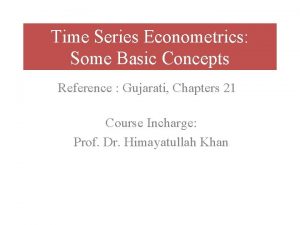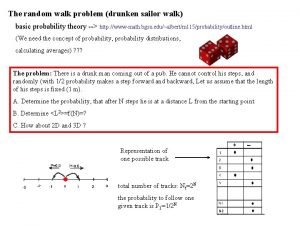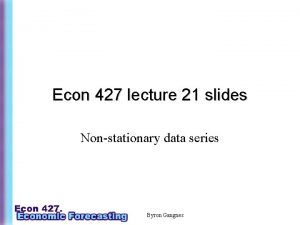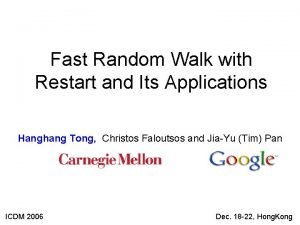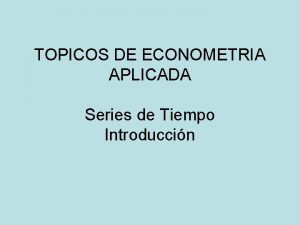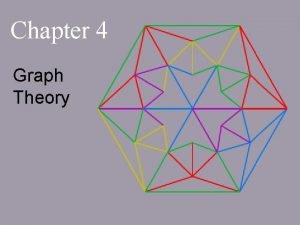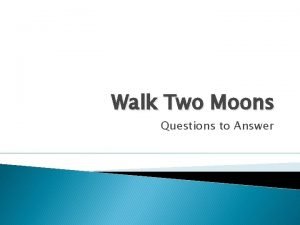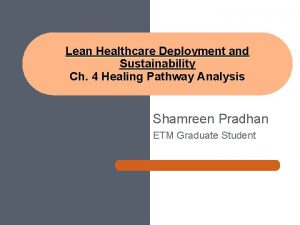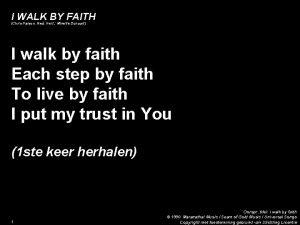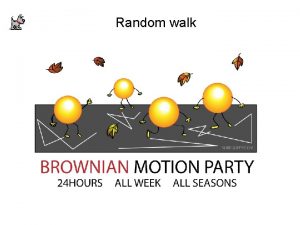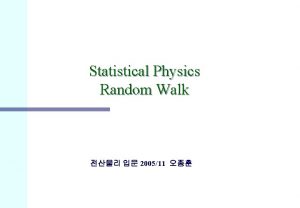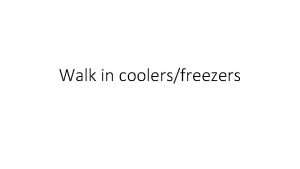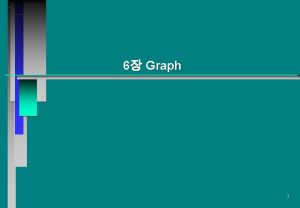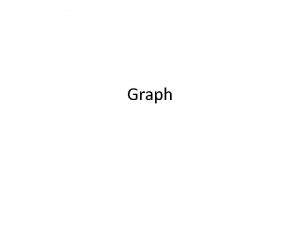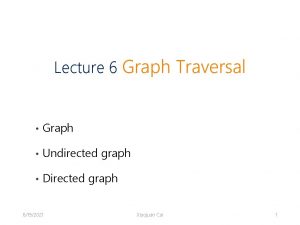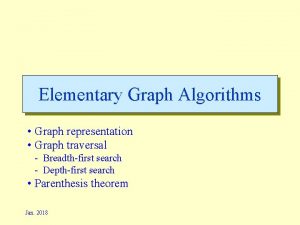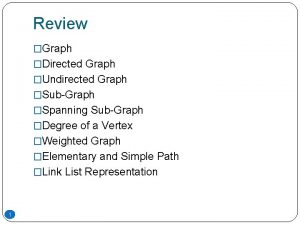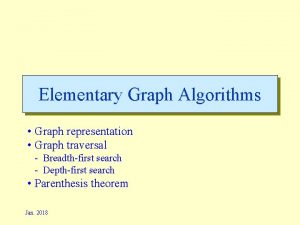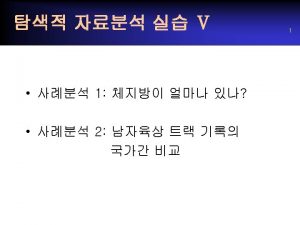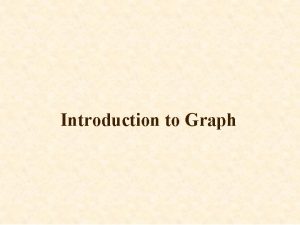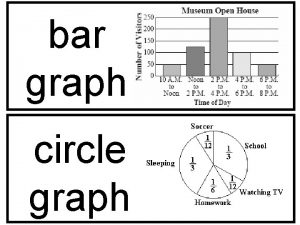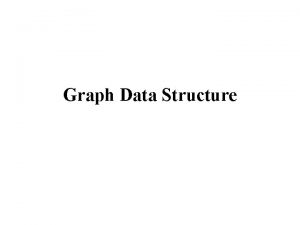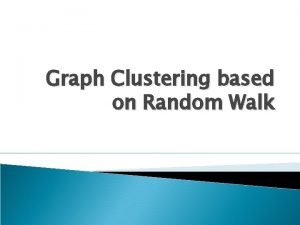Random Walk on Graph t0 Random Walk Start












































- Slides: 44

Random Walk on Graph t=0 Random Walk Ø Start from a given node at time 0 Ø Choose a neighbor randomly (including previous) and move there Ø Repeat until time t = n Q 1. Where does this converge to as n ∞ Q 2. How fast does it converge? Q 3. What are the implications for different applications? Thrasyvoulos Spyropoulos / spyropou@eurecom. fr Eurecom, Sophia-Antipolis 1

Random Walks on Graphs Ø Node degree ki move to any neighbor with prob = 1/ki 0 1 1 0 0 0 1 1 0 1/k 2 0 1 1 0 0 1 1 A= 1/k 1 0 0 1/k 2 0 1/k 3 0 0 1/k 3 1 0 1/k 4 0 0 0 1/k 5 0 Ø This is a Markov chain! Ø Start at a node i p(0) = (0, 0, …, 1, … 0, 0) Ø p(n) = p(0) An Ø π = π A [where π = limn ∞ p(n)] Q: what is π for a random walk on a graph? Thrasyvoulos Spyropoulos / spyropou@eurecom. fr Eurecom, Sophia-Antipolis 2

Random Walks on Undirected Graphs Ø Stationarity: π(z) = Σxπ(x)p(x, z) v p(x, y) = 1/kx Ø Could try to solve these or global balance. Not Easy!! Ø Define N(z): {neighbors of z) Σx ∈ N(z) kx⋅p(x, z) = Σx ∈ N(z) kx⋅(1/kx) = Σx ∈ N(z)1 = kz Ø Normalize by (dividing both sides with) Σxkx v Σxkx = 2|E| (|E| = m = # of edges) Σx ∈ N(z) (kx/2|E|)⋅p(x, z) = kz/2|E| Ø π(x) = kx/2|E| is the stationary distribution v always satisfies the stationarity eq π(x) = π(x)P Thrasyvoulos Spyropoulos / spyropou@eurecom. fr Eurecom, Sophia-Antipolis 3

What about Random Walks on Directed Graphs? 1/8 4/13 1/8 1/8 2/13 1/8 1/13 1/13 Ø Assign each node centrality 1/n (for n nodes) Thrasyvoulos Spyropoulos / spyropou@eurecom. fr Eurecom, Sophia-Antipolis 4

A Problematic Graph Q: What is the problem with this graph? A: All centrality “points” will eventually go to F and G Solution: when at node i 1) 2) With probability β jump to any (of the total N) node(s) With 1 -β jump to a random neighbor of i Q: Does this remind you of something? A: Page. Rank algorithm! Page. Rank of node i is the stationary probability for a random walk on this (modified) directed graph v factor β in Page. Rank function avoids this problem by “leaking” some small amount of centrality from each node to all other nodes Thrasyvoulos Spyropoulos / spyropou@eurecom. fr Eurecom, Sophia-Antipolis 5

Page. Rank Centrality Page. Rank as a Random Walk Ø A (bored) web surfer Ø Either surf a linked webpage with probability 1 -β Ø Or surf a random page (e. g. new search) with probability β Ø The probability of ending up at page X, after a large enough time = Page. Rank of page X! Ø Can generalize Page. Rank with general β = (β 1, β 2, …, βn) Ø Undirected network: removing β degree centrality Thrasyvoulos Spyropoulos / spyropou@eurecom. fr Eurecom, Sophia-Antipolis 6

Applications of RW: Measuring Large Networks Ø We are interested in studying the properties (degree distribution, path lengths, clustering, connectivity, etc. ) of many real networks (Internet, Facebook, You. Tube, Flickr, etc. ) as this contain many important ($$$) information Ø E. g. to plot degree distribution, we need to crawl the whole network and obtain a “degree value” for each node. Ø This networks might contain millions of nodes!! Thrasyvoulos Spyropoulos / spyropou@eurecom. fr Eurecom, Sophia-Antipolis 7

Online Social Networks (OSNs) October 2010 Size Traffic 500 million 2 200 million 9 130 million 12 100 million 43 75 million 10 75 million 29 > 1 billion users (over 15% of world’s population, and over 50% of world’s Internet users !) Thrasyvoulos Spyropoulos / spyropou@eurecom. fr Eurecom, Sophia-Antipolis

Measuring Face. Book Facebook: • 500+M users • 130 friends each (on average) • 8 bytes (64 bits) per user ID The raw connectivity data, with no attributes: • 500 x 130 x 8 B = 520 GB To get this data, one would have to download: • 100+ TB of (uncompressed) HTML data! This is neither feasible nor practical. Solution: Sampling! Thrasyvoulos Spyropoulos / spyropou@eurecom. fr Eurecom, Sophia-Antipolis

Measuring Large Networks (for the mere mortals) ØObtaining complete dataset difficult companies usually unwilling to share data v for privacy and performance reasons (e. g. Facebook will ban accounts if it sees extensive crawling) v tremendous overhead to measure all (~100 TB for Facebook) v ØRepresentative samples desirable study properties v test algorithms v Thrasyvoulos Spyropoulos / spyropou@eurecom. fr Eurecom, Sophia-Antipolis

Sampling What: • Topology? • Nodes? Thrasyvoulos Spyropoulos / spyropou@eurecom. fr How: • Directly? • Exploration? Eurecom, Sophia-Antipolis

(1) Breadth-First-Search (BFS) Ø Starting from a seed, explores all neighbor nodes. Process continues iteratively without replacement. Ø BFS leads to bias towards high degree nodes v Lee et al, “Statistical properties of Sampled Networks”, Phys Review E, 2006 Ø Early measurement studies of OSNs use BFS as primary sampling technique v i. e [Mislove et al], [Ahn et al], [Wilson et al. ] Thrasyvoulos Spyropoulos / spyropou@eurecom. fr Eurecom, Sophia-Antipolis

(2) Random Walk (RW) Ø Explores graph one node at a time with replacement Ø Restart from different seeds Ø Or multiple seeds in parallel Ø Does this lead to a good sample? ? Thrasyvoulos Spyropoulos / spyropou@eurecom. fr Eurecom, Sophia-Antipolis

Implications for Random Walk Sampling Ø Say, we collect a small part of the Facebook graph using RW Ø Higher chance to visit high-degree nodes High-degree nodes overrepresented v Low-degree nodes under-represented v sampled degree distribution 2? Random Walk (RW): sampled degree distribution 1? Real degree distribution [1] M. Gjoka, M. Kurant, C. T. Butts and A. Markopoulou, “Walking in Facebook: A Case Study of Unbiased Sampling of OSNs”, INFOCOM 2010. Thrasyvoulos Spyropoulos / spyropou@eurecom. fr Eurecom, Sophia-Antipolis

Random Walk Sampling of Facebook real sampled Real average node degree: 94 Observed average node degree: 338 Q: How can we fix this? A: Intuition Need to reduce (increase) the probability of visiting high (low) degree nodes Thrasyvoulos Spyropoulos / spyropou@eurecom. fr Eurecom, Sophia-Antipolis 15

Markov Chain Monte Carlo (MCMC) Q: How should we modify the Random Walk? A: Markov Chain Monte Carlo theory Ø Original chain: move x y with prob Q(x, y) v Stationary distribution π(x) v Ø Desired chain: v Stationary distribution w(x) (for uniform sampling: w(x) = 1/N) Ø New transition probabilities Thrasyvoulos Spyropoulos / spyropou@eurecom. fr Eurecom, Sophia-Antipolis 16

MCMC (2) Ø a(x, y): probability of accepting proposed move Q: How should we choose a(x, y) so as to converge to the desired stationary distribution w(x)? A: w(x) station. distr. w(x)P(x, y) = w(y)P(y, x) (for all x, y) Q: Why? Local balance (time-reversibility) equations w(x)Q(x, y)a(x, y) = w(y)Q(y, x)a(y, x) (denote b(x, y) = b(y, x)) a(x, y) ≤ 1 (probability) b(x, y) ≤ w(x)Q(x, y) b(x, y) = b(y, x) ≤ w(y)Q(y, x) Thrasyvoulos Spyropoulos / spyropou@eurecom. fr Eurecom, Sophia-Antipolis 17

MCMC for Uniform Sampling Ø w(x) = w(y) (= 1/n…doesn’t really matter) Ø Q(y, x)/Q(x, y) = kx/ky Ø Metropolis-Hastings random walk: Move to lower degree node always accepted v Move to higher degree node reject with prob related to degree ratio v Thrasyvoulos Spyropoulos / spyropou@eurecom. fr Eurecom, Sophia-Antipolis 18

Metropolis-Hastings (MH) Random Walk § Explore graph one node at a time with replacement § In the stationary distribution Thrasyvoulos Spyropoulos / spyropou@eurecom. fr Eurecom, Sophia-Antipolis

Degree Distribution of FB with MHRW Ø Sampled degree distribution almost identical to real one Ø MCMC methods have MANY other applications Sampling v Optimization v Thrasyvoulos Spyropoulos / spyropou@eurecom. fr Eurecom, Sophia-Antipolis 20

Spectral Analysis of (ergodic) Markov Chains Ø If a Markov Chain (defined by transition matrix P) is ergodic (irreducible, aperiodic, and positive recurrent) P(n)ik πk and π = [π1, π2, …, πn] Q: But how fast does the chain converge? E. g. how many steps until we are “close enough” to π A: This depends on the eigenvalues of P The convergence time is also called the mixing time Thrasyvoulos Spyropoulos / spyropou@eurecom. fr Eurecom, Sophia-Antipolis 21

Eigenvalues and Eigenvectors of matrix P Left Eigenvectors A row vector π is a left eigenvector for eigenvalue λ of matrix P iff πP = λπ Σk πk pki = λπi Right Eigenvectors A column vector v is a right eigenvector for eigenvalue λ of matrix P iff Pv = λv Σk pik vk = λvi Q: What eigenvalues and eigenvectors can we guess already? A: λ = 1 is a left eigenvalue with eigenvector π the stationary distr. λ = 1 is a right eigenvalue with eigenvector v=1 (all 1 s) Thrasyvoulos Spyropoulos / spyropou@eurecom. fr Eurecom, Sophia-Antipolis 22

Eigenvalues and Eigenvectors for 2 -state Chains Ø Both sets have non-zero solutions (P-λI) is singular v There exists v ≠ 0 such that (P-λI)v = 0 ÞDeterminant |P-λI| = 0 Þ(p 11 - λ)(p 22 - λ)-p 12 p 21 = 0 Þ λ 1=1, λ 2 = 1 – p 12 – p 21 (replace above and confirm using some algebra) v |λ 2| < 1 (normalized: π(1) to be a stationary distribution AND v(i) ∙π(i) = 1, ∀i) Thrasyvoulos Spyropoulos / spyropou@eurecom. fr Eurecom, Sophia-Antipolis 23

Diagonalization ÞEigenvalue decomposition: P = U Λ U-1 Q: What is P(n)? A: => Q: How fast does the chain converge to stationary distrib. ? A: It converges exponentially fast in n, as (λ 2)n Thrasyvoulos Spyropoulos / spyropou@eurecom. fr Eurecom, Sophia-Antipolis 24

Generalization for M-state Markov Chains Ø We’ll assume that there are M distinct eigenvalues (see notes for repeated ones) Ø Matrix P is stochastic all eigenvalues |λi| ≤ 1 Q: Why? A: Q: How fast does an (ergodic) chain converge to stationary distribution? A: Exponentially with rate equal to 2 nd largest eigenvalue Thrasyvoulos Spyropoulos / spyropou@eurecom. fr Eurecom, Sophia-Antipolis 25

Speed of Sampling on this Network? 26 Ø λ 2 (2 nd largest eigenvalue) related to (balanced) min-cut of the graph Ø The more “partitioned” a graph is into clusters with few links between them the longer the convergence time for the respective MC the slower the random walk search Thrasyvoulos Spyropoulos / spyropou@eurecom. fr Eurecom, Sophia-Antipolis 26

Community Detection - Clustering Thrasyvoulos Spyropoulos / spyropou@eurecom. fr Eurecom, Sophia-Antipolis

Device-to-Device Communication (e. g. Bluetooth or Wi. Fi Direct) Thrasyvoulos Spyropoulos / spyropou@eurecom. fr Eurecom, Sophia-Antipolis

Data/Malware Spreading Over Opp. Nets D F E D B D D A D D C § Contact Process: Due to node mobility § Q: How long until X% of nodes “infected”? Thrasyvoulos Spyropoulos / spyropou@eurecom. fr Eurecom, Sophia-Antipolis

News/Videos on Online Social Networks interaction (post, share) i j Ø Contact/Interaction: (random) times when user i posts/writes to user j, or user j checks out i’s page. v “transfer” during a contact with probability p Ø Q: How long until a video goes “viral”? Thrasyvoulos Spyropoulos / spyropou@eurecom. fr Eurecom, Sophia-Antipolis

Email Network § An email with a virus or worm § A graph showing which users send emails to whom § Pairwise contact process: (random) times of emails between i and j § Q: How long for the worm to spread? ? Thrasyvoulos Spyropoulos / spyropou@eurecom. fr Eurecom, Sophia-Antipolis

Diffusion in networks: ER graphs http: //www. ladamic. com/netlearn/Net. Logo 501/ERDiffusion. htm l Thrasyvoulos Spyropoulos / spyropou@eurecom. fr Eurecom, Sophia-Antipolis

ER graphs: connectivity and density nodes infected after 10 steps, infection rate = 0. 15 average degree = 2. 5 Thrasyvoulos Spyropoulos / spyropou@eurecom. fr average degree = 10 Eurecom, Sophia-Antipolis

Quiz Q: Ø When the density of the network increases, diffusion in the network is faster v slower v unaffected v Thrasyvoulos Spyropoulos / spyropou@eurecom. fr Eurecom, Sophia-Antipolis

Diffusion in “grown networks” Ø nodes infected after 4 steps, infection rate = 1 preferential attachmentnon-preferential growth http: //www. ladamic. com/netlearn/Net. Logo 501/BADiffusion. html Thrasyvoulos Spyropoulos / spyropou@eurecom. fr Eurecom, Sophia-Antipolis

Quiz Q: Ø When nodes preferentially attach to high degree nodes, the diffusion over the network is faster v slower v unaffected v Thrasyvoulos Spyropoulos / spyropou@eurecom. fr Eurecom, Sophia-Antipolis

Diffusion in small worlds Ø What is the role of the long-range links in diffusion over small world topologies? http: //www. ladamic. com/netlearn/Net. Logo 4/Small. World. Diffusion. SIS. html Thrasyvoulos Spyropoulos / spyropou@eurecom. fr Eurecom, Sophia-Antipolis

Quiz Q: Ø As the probability of rewiring increases, the speed with which the infection spreads increases v decreases v remains the same v Thrasyvoulos Spyropoulos / spyropou@eurecom. fr Eurecom, Sophia-Antipolis

Analysis of Epidemics: The Usual Approach Assumption 1) Underlay Graph Fully meshed Assumption 2) Contact Process Poisson(λij), Indep. Assumption 3) Contact Rate λij = λ (homogeneous) Thrasyvoulos Spyropoulos / spyropou@eurecom. fr Eurecom, Sophia-Antipolis

Modeling Epidemic Spreading: Markov Chains (MC) 2 -hop infection Thrasyvoulos Spyropoulos / spyropou@eurecom. fr Eurecom, Sophia-Antipolis

How realistic is this? A Poisson Graph A Real Contact Graph (ETH Wireless LAN trace) Thrasyvoulos Spyropoulos / spyropou@eurecom. fr Eurecom, Sophia-Antipolis

Arbitrary Contact Graphs Thrasyvoulos Spyropoulos / spyropou@eurecom. fr Eurecom, Sophia-Antipolis

Bounding the Transition Delay Ø What are we really saying here? ? Ø Let a = 3 how can split the graph into a subgraph of 3 and a subgraph of N-3 node, by removing a set of edges whose weight sum is minimum? Thrasyvoulos Spyropoulos / spyropou@eurecom. fr Eurecom, Sophia-Antipolis

A 2 nd Bound on Epidemic Delay Ø Φ is a fundamental property of a graph Ø Related to graph spectrum, community structure Thrasyvoulos Spyropoulos / spyropou@eurecom. fr Eurecom, Sophia-Antipolis
 But we gotta start somewhere
But we gotta start somewhere Triage disaster
Triage disaster Econometrics basic concepts
Econometrics basic concepts Drunken sailor problem
Drunken sailor problem Lognormal random walk
Lognormal random walk Random walk with drift
Random walk with drift Random walk problem
Random walk problem Scaled random walk
Scaled random walk Pagerank random walk
Pagerank random walk Fast random walk with restart and its applications
Fast random walk with restart and its applications Random walk econometria
Random walk econometria Efficient market hypothesis
Efficient market hypothesis How to take a random sample in jmp
How to take a random sample in jmp Random assignment vs random sampling
Random assignment vs random sampling Random assignment vs random selection
Random assignment vs random selection Walk in graph theory
Walk in graph theory Walk in graph theory
Walk in graph theory Handshaking theorem
Handshaking theorem Wait-for graph
Wait-for graph Whales use to walk on land
Whales use to walk on land Http://www.waterforsouthsudan.org
Http://www.waterforsouthsudan.org Lines that bend and change direction gradually
Lines that bend and change direction gradually Walk worthy of the calling
Walk worthy of the calling Walk two moons questions and answers
Walk two moons questions and answers Walk two moons chapter 29
Walk two moons chapter 29 Www.fors-online.org.uk
Www.fors-online.org.uk Daily walk around check sheet
Daily walk around check sheet Dsc walk test
Dsc walk test British cartoon by david low 1934
British cartoon by david low 1934 Sample letter for walk to emmaus
Sample letter for walk to emmaus Powerful verbs for ate
Powerful verbs for ate Spirit walk: exploration
Spirit walk: exploration Theme of long walk to forever
Theme of long walk to forever Llano estacado emmaus
Llano estacado emmaus Waste walk
Waste walk I walk by faith chris falson
I walk by faith chris falson British artist
British artist A bird came down the walk summary
A bird came down the walk summary Take right
Take right Gallery walk discussion
Gallery walk discussion Walk a thon ideas
Walk a thon ideas Inform 3. hali
Inform 3. hali Even though i walk through the valley
Even though i walk through the valley Walk worthy of your calling
Walk worthy of your calling Market structures gallery walk answers
Market structures gallery walk answers


